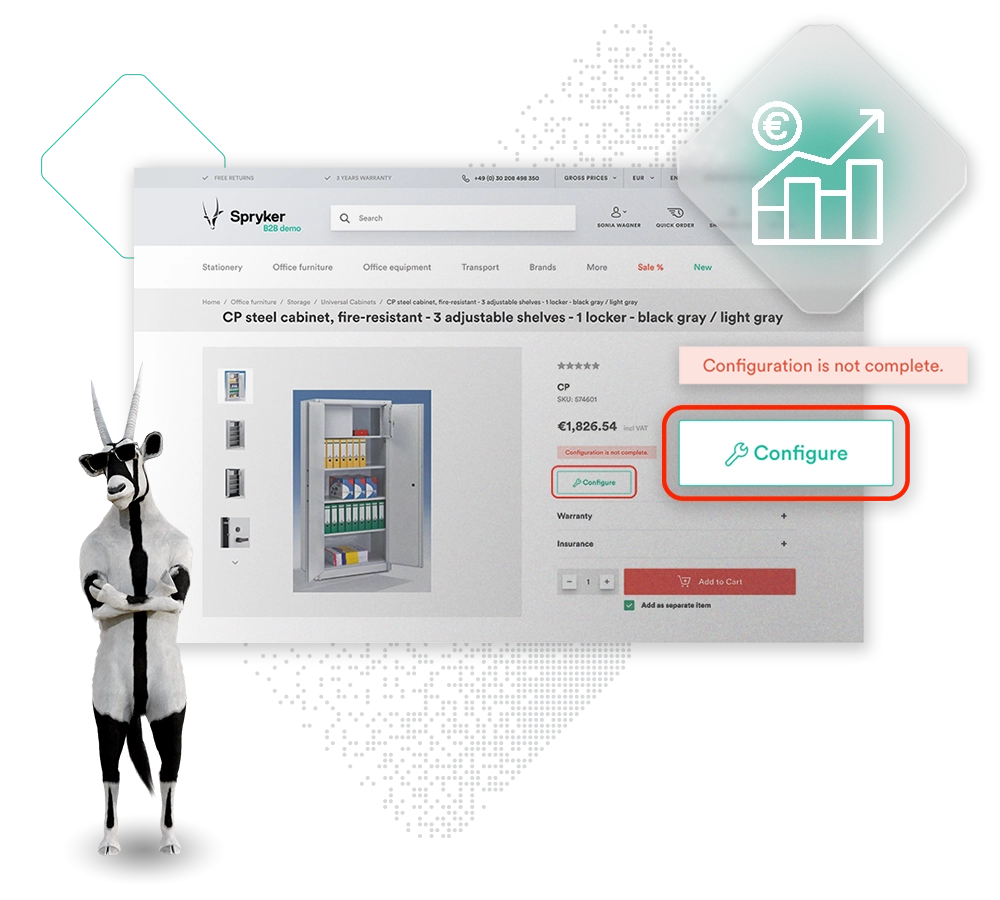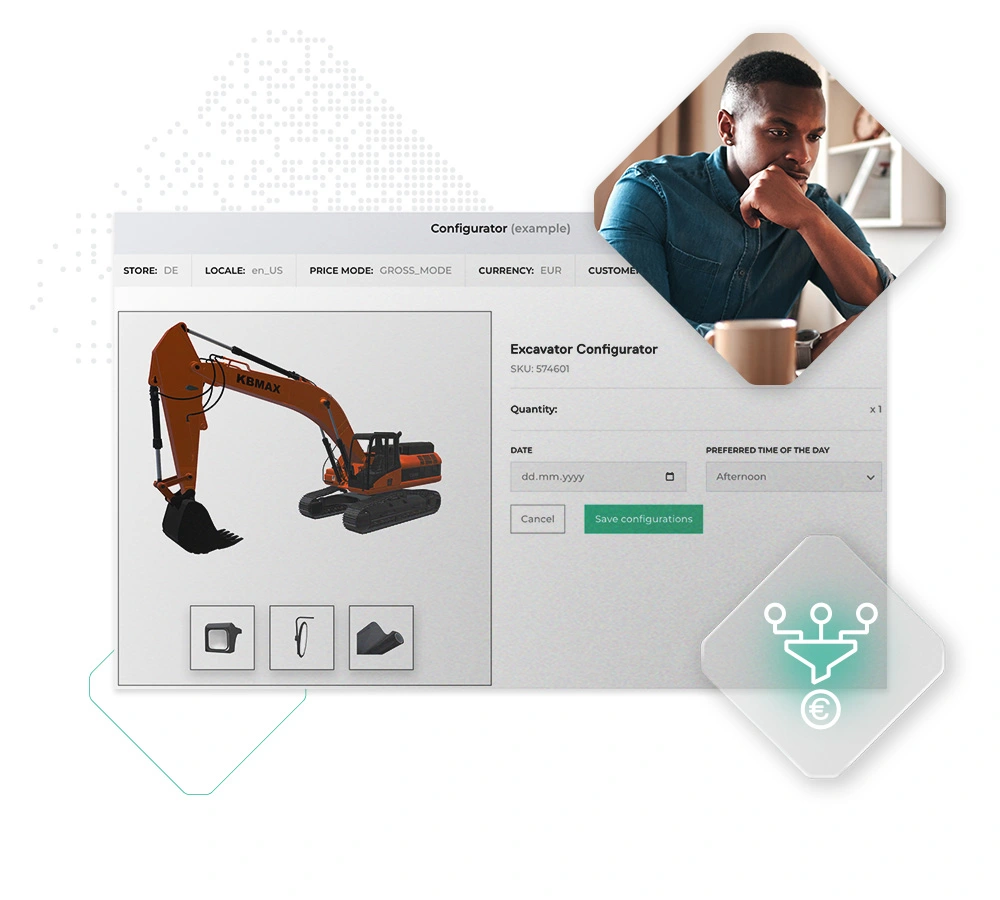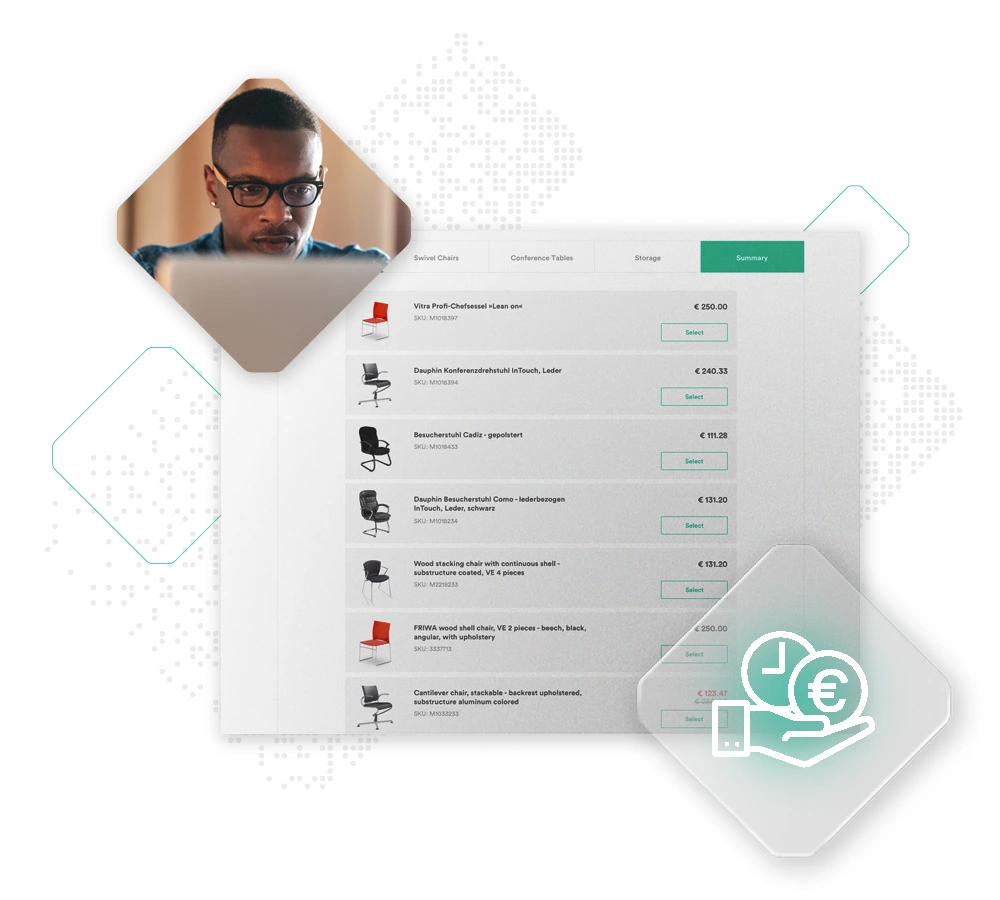Selling Complex Products & Configurations
Harnessing the power of personalization: reduce costs and increase customer satisfaction with customizable goods.Status Quo
Complex products are those that require a high level of customization, tailored to meet specific requirements. As customers increasingly seek personalized and unique products, the demand for complex offerings with customized configurations is on the rise.
To meet these evolving customer needs, businesses must adapt and provide self-service capabilities. By embracing digital platforms, companies can streamline the sales process, reduce costs, and improve efficiency without relying heavily on the sales team.
The digital realm enables businesses to offer personalized and configured products online, expanding their reach to a wider audience in the digital marketplace. By catering to individual preferences, companies can access a world of untapped potential, opening doors to growth and success.

Selling Complex Products Addresses These Challenges
Managing complex products and configurations poses several challenges in today's business environment. With the increasing demand for unique configurations, companies must adapt to cater to individual customer preferences. This demand leads to a lengthy and cumbersome sales process, often causing frustration and inefficient communication.
- Increased demand for unique configurations: Customers increasingly seek personalized and tailored products. Currently, it’s difficult to find the right product for their specific needs.
- Lengthy and cumbersome sales process: Traditional sales processes for complex products often involve lengthy negotiations, multiple meetings, and manual documentation. Complex products and services require assistance and guidance.
- Customer frustration and inefficient communication: The complexity in products and processes can lead to misinterpretation or miscommunication which increases the risk of errors and misunderstandings.
- Inventory management challenges: Managing inventory for complex products with multiple configurations can be challenging and resource- intensive. Real-time data on customer preferences and demand is hard to gather for better planning.
Increase reach and attract new customers
- Businesses can cater to a larger audience and expand their reach in the digital marketplace.
- The personalization available creates a highly tailored shopping experience that will attract new customers.
- Selling complex products digitally means you can harness vizualizaiton technology such as 3D models or augmented reality. This attracts new customers as they can see a realistic and detailed digital version of the final result.


Increase revenue and market share
- Unlock new revenue streams.
- Businesses can tap into a growing demand for personalized products and services, differentiating themselves from competitors who may only offer off-the-shelf solutions.
- Capture untapped demand by catering to niche or specialized markets that require customizable products.
Reduce costs and increase efficiency
- Streamline the sales process by automating product configuration, pricing, and order management. This reduces manual errors and the need for human intervention.
- Reduce overhead and save costs as traditional elements like physical showrooms are no longer needed.
- Increase scalability of complex products by replicating successful sales processes for new customers.


Improve customer satisfaction and convenience
- Customers feel that their needs are being met.
- Customers have greater choice and access to a wider range of customization options to find the perfect product.
- Easy to explore, customize and purchase without in-person consultation or lengthy negotiations.
How Does Selling Complex Products & Configurations Work?
Different configuration models are used to manage and present customization options for products and services
Component-based configuration
- Products are configured by selecting individual components and assembling them to create the final product.
- Each component can have its own set of features and options, which customers can choose from.
Examples:
- Consumer Electronics
- Automotive
- Computers
Rule-based configuration
- Relies on a set of predefined rules and constraints to guide customers through the customization process.
- Ensures that only valid combinations of features and options are allowed, preventing incompatible configurations.
- Often employed in industries with complex products.
- Industrial Machinery
- Software Solutions
Parametric configuration
- Allows customers to input specific values or parameters to determine the final product configuration.
- Useful for products that require precise measurements or specifications, such as custom-sized furniture or tailored clothing.
- Furniture
- Fashion
- Construction
Variations
- Products are represented with different standardized set of features or options, like color, materials, designs.
- Customers can only select from given options/matrix.
- Fashion
- Consumer Electronics
- FCMG
Bundle configuration
- Involves grouping various product options or features into pre-defined packages or bundles.
- Customers can select a bundle that best suits their needs, rather than choosing individual options.
- Simplifies the customization process and is commonly used for services.
- Software subscriptions
- Telecommunication plans
Hierarchical configuration
- Organizes product options and features in a tree-like structure, with each level representing a different category or aspect of the product.
- Customers can navigate through the hierarchy to select their desired options.
- Useful for products with a large number of features or options.
- Automotive accessories
- Home appliances
Accurate product representation
- Companies must ensure that their digital platforms can accurately showcase complex product configurations and customization options, providing customers with a clear understanding of what they are purchasing.
Streamlined customer experience
- Businesses need to create an intuitive and seamless user experience that guides customers through the customization process, making it easy to understand and navigate.
Integration with existing systems
- Companies must integrate their e-commerce platforms with existing manufacturing and supply chain systems, ensuring a smooth transition from order placement to delivery.
Pricing and quoting
- Accurate and dynamic pricing models need to be implemented, taking into account the numerous customization options and potential changes to the order.
Spryker Capabilities
- Product Information Management
- Configurable Product
- Configurable Bundle
- Product Bundles
- Product Options
- Product Relations
- Price Management
- Quotation Management
Success Enabling Services
- Customer Journey Analysis
- Operating Model Sparring
- Process Design Workshop
- Capability Mapping
- Business Model Challenge
- Readiness Audit
Technology Partners
- CDS Visual
- Infobip
- Vonage
Customer Example
FIBROCustomer challenge:
As a leading provider for Standard Parts for the tool & die industry, FIBRO offers a unique range of high precision products. With over a million different items, FIBRO Standard Parts is a guaranteed one-stop shop for tool manufacturers around the world. The sophisticated quality requirements of their customers are fulfilled through the highest processing accuracies and minimum tolerances of their products. FIBRO offers both a high level of standardization and configured parts designed to overcome highly specific problems. The product complexity and configurations typically demand a higher level of involvement from both FIBRO and the customer, however the new generation of buyers expects self-service capabilities.
Solution:
FIBRO offers an eshop to configure products online with the wide range of services to support customers in multiple ways; for example with direct contact to select appropriate product-selection and design, by providing the necessary CAD-data and guarantee a optimum workflow in shipping.
Outcomes:
FIBRO helps to improve customer satisfaction and convenience by allowing customers to feel that their needs are being met. Customers have a greater choice and access to a wider range of customization options to find the perfect product online without in-person consultations.
About Spryker
Spryker is the leading global composable commerce platform for enterprises with sophisticated business models to enable growth, innovation, and differentiation. Designed specifically for sophisticated transactional businesses, Spryker’s easy-to-use, headless, API-first model offers a best-of-breed approach that provides businesses the flexibility to adapt, scale, and quickly go to market while facilitating faster time-to-value throughout their digital transformation journey. As a global platform leader for B2B and B2C Enterprise Marketplaces, IoT Commerce, and Unified Commerce, Spryker has empowered 150+ global enterprise customers worldwide and is trusted by brands such as ALDI, Siemens, ZF Friedrichshafen, and Ricoh. Spryker is a privately held technology company headquartered in Berlin and New York backed by world class investors such as TCV, One Peak, Project A, Cherry Ventures, and Maverick Capital. Learn more at spryker.com.